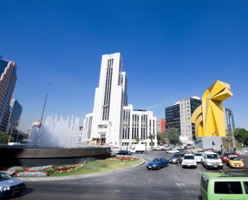 No doubt Mexico's reputation has been tarnished by reports about drug-related violence, and increasing economic risks may prompt multinationals to think twice about moving in, but the country retains a relatively business-friendly environment compared to other emerging markets.
No doubt Mexico's reputation has been tarnished by reports about drug-related violence, and increasing economic risks may prompt multinationals to think twice about moving in, but the country retains a relatively business-friendly environment compared to other emerging markets.
In December 2008, Coface dropped its country-risk assessment on Mexico by one notch, to A4 from A3. The assessment, which evaluates the macroeconomic and political outlook for a country, is still above average for emerging market countries.
“Mexico is one of the few emerging-market countries which was a bit overrated before the financial crisis,” says Yves Zlotowski, chief economist at Coface, a credit-insurance subsidiary of Natixis that provides a variety of services enabling companies to manage their global business risks.
The downgrade reflected the country's increasing political and economic risks, as violence continued unabated, the downturn in the U.S. depressed remittance payments sent by Mexican immigrants, and companies in Mexico lost market share to lower-cost Chinese rivals. In March 2009, Coface put Mexico's rating on negative watch, which it removed in 2010.
The impact of the escalating violence appears to have had a more psychological than practic al effect on multinationals operating businesses in Mexico. In a July report, Standard & Poor's said equipment manufacturers continue to expand their operations in Mexico, drawn by low wages and the fact there are no tariffs on vehicle parts imported to the U.S. The ratings agency acknowledges that the increasing violence is a risk for companies, but so far not one that outweighs the benefits.
al effect on multinationals operating businesses in Mexico. In a July report, Standard & Poor's said equipment manufacturers continue to expand their operations in Mexico, drawn by low wages and the fact there are no tariffs on vehicle parts imported to the U.S. The ratings agency acknowledges that the increasing violence is a risk for companies, but so far not one that outweighs the benefits.
“We haven't seen any evidence of disruptions in this or any other important industries within the country,” the S&P report says.
Mexico's current country-risk assessment from Coface puts it at the same level as up-and-coming Colombia, which was upgraded to A4 from B in 2007. Zlotowski notes that the country assessment is separate from Mexico's business-environment assessment, which remains a relatively strong A4—the same as Brazil's and Colombia's.
“In terms of financial transparency, it's a rather good country. But the macroeconomic and political environment is a bit more fragile than we had thought,” Zlotowski says.
Mexico also tends to be more open to foreign investment than many emerging markets. Its derivatives exchange, for example, allows for remote memberships, so non-Mexican broker-dealers can become members without incorporating in the country, potentially facilitating corporate clients' hedging opportunities.
In addition, Daniel Perkins, a member of Accenture's treasury management practice, points out that unlike most developing countries Mexico has permitted foreign banks to join its clearing system. “So multinational firms can use those banks to collect local payments,” Perkins says.
See more stories here about countries where multinationals have spotted opportunities.
© Touchpoint Markets, All Rights Reserved. Request academic re-use from www.copyright.com. All other uses, submit a request to [email protected]. For more inforrmation visit Asset & Logo Licensing.



